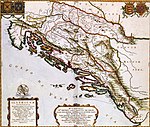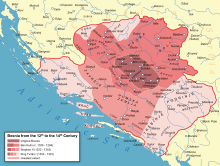Type a search term to find related articles by LIMS subject matter experts gathered from the most trusted and dynamic collaboration tools in the laboratory informatics industry.
| Bosnia Bosna Босна | |||||||||
|---|---|---|---|---|---|---|---|---|---|
| 8/9th century–1154 | |||||||||
| Capital | possibly Katera or Desnik | ||||||||
| Demonym | Bosnians | ||||||||
| Government | |||||||||
| • Type | Principality | ||||||||
| Knez | |||||||||
• 838 AD | Ratimir | ||||||||
| History | |||||||||
• Established | 8/9th century | ||||||||
| 1154 | |||||||||
| |||||||||
| Today part of | |||||||||
Bosnia (Greek: Βοσωνα, romanized: Bosona, Serbo-Croatian: Босна, Bosna), in the Early Middle Ages to early High Middle Ages, was a territorially and politically defined South Slavic defined entity,[1] governed at first by knez and then by a ruler with the ban title, possibly from at least 838 AD.[2][3] Situated, broadly, around upper and middle course of the Bosna river, between valleys of the Drina river on the east and the Vrbas river on the west, which comprise a wider area of central and eastern modern-day Bosnia and Herzegovina.

The very nucleus where the first Bosnian state emerged and had developed is Visoko valley, surrounding a wider area of modern-day town of Visoko.[4][5] This area will be known as župa Bosna, as nucleus of the zemlja Bosna.[6] The early Bosnia, according to Vego and Mrgić, as well as Hadžijahić and Anđelić, was situated, broadly, around the Bosna river, between its upper and the middle course: in the south to north direction between the line formed by its source and the Prača river in the south, and the line formed by the Drinjača river and the Krivaja river (from Olovo, downstream to town of Maglaj), and Vlašić mountain in the north, and in the west to east direction between the Rama-Vrbas line stretching from the Neretva to Pliva in the west, and the Drina in the east, which is a wider area of central and eastern modern-day Bosnia and Herzegovina.[7][8][9]
Confirmation of its emergence and territorial distribution comes from historiographical interpretation of Bar's Chronicle in modern and post-modern scholarship, which situate the state around the Upper Bosna river and the Upper Vrbas river, including Uskoplje, Pliva and Luka.[8] This also suggest that this distribution from the Bosna river valley into the Vrbas river valley is the earliest recorded. These three small parishes will later become a quintessence for emergence of Donji Kraji county, before they were reclaimed as Kotromanić's demesne, after 1416 and death of Hrvoje Vukčić Hrvatinić.[10][8]
| History of Bosnia and Herzegovina |
|---|
 |
|
|

The western Balkans had been reconquered from "barbarians" by Roman Emperor Justinian (r. 527–565). Sclaveni (Slavs) raided the western Balkans, including Bosnia, in the 6th century.[11] The first mention of a Bosnian entity comes from the De Administrando Imperio (DAI in further text),[12] which mention Bosnia (Βοσωνα/Bosona) as a "small/little land" or a "small country",[12] χοριον Βοσωνα/horion Bosona,[13] positioned in the upper course of the Bosna river, settled by Slavs who in time created their own unit with a ruler calling himself a Bosnian.[14][15][16][17]
Historical and archaeological information on early medieval Bosnia remains inadequate.[18] According to DAI, Bosnia included two inhabited towns,[19] Katera and Desnik.[20] Katera has been thought to be identified as Kotorac near Sarajevo, however, according to Bulić 2013, archaeology refutes this. Katera may have been situated in the vicinity of modern-day Kotor Varoš, the potential site could be Bobac or Bobos, however, site only includes late medieval findings to date.[19] Desnik remains wholly unidentified, but was thought to be near Dešanj.[19] Hadžijahić wholly rejected the information about location of the two towns in Bosnia, arguing that the Greek preposition in the sentence is often erroneously translated (as "in" instead of "toward"), referring to two Serbian towns toward land of Bosnia.[21] Relja Novaković also questioned why there was an additional mention of a land with own cities if they should be part of Serbia, concluding that Bosnia almost always was a separate country.[22] Francis Dvornik stated to be, "most probable-and this is accepted by most historians of the period", initially formed as part of Croatia and later in mid-10th century was ruled by Serbia.[23]
If DAI's kastra oikoumena does not designate inhabited towns, but ecclesiastical centers instead (in 6th century is mentioned Bestoen bishopric with several episcopal centers that belonged to Salonitan Archdiocese[24][25][26][27]), as theorized by late Tibor Živković, the two towns in question might be Bistua (Zenica or Vitez) and Martar (probably Konjic).[19] The existence of such centers is argued by Živković as evidence it was an independent state before 822.[28] By the late 9th and early 10th century, Bosnia was mostly Christianized by Latin priests from the Dalmatian coastal towns, though remote pockets remained unreached.[29] After the East–West Schism (1054) the bishopric of Bosnia was Roman Catholic under jurisdiction of the Archbishop of Split (since the 12th century under Roman Catholic Diocese of Dubrovnik).[30] In the 11-12th centuries the "Latin rite Christianity was prevalent in the west, the north and in central Bosnia", while the "Orthodox faith was predominant in the eastern districts near Serbia and the River Drina".[31]
Northern and Northeastern Bosnia was captured by Carolingian Franks in the early 9th century and remained under their jurisdiction until 870s.[32] In what is now eastern Herzegovina and Montenegro, semi-independent localities emerged under Serbian rule.[32] In the 910s Petar of Serbia annexed entire Eastern Bosnia by defeating local Slavic lord Tišemir of Bosnia,[33] and pushing into Zahumlje came into conflict with Michael of Zahumlje.[34] Croatian king Tomislav reintegrated parts of Western and Northern Bosnia,[32][35] battling the Bulgarians in the Bosnian highlands (926).[36] In 949, a civil war broke out in Croatia leading to the conquest of Bosnia by Časlav, but after his death in c. 940s/960s,[37][32] it was retaken by Michael Krešimir II of Croatia,[37][38][39] or became politically independent.[8][40] Bulgaria briefly subjugated Bosnia at the turn of the 10th century, after which followed period of Byzantine rule.[40] In the early 11th century, Bosnia was briefly part of the state of Duklja.[40][31] In 1019 Byzantine Emperor Basil II forced the Serb and Croat rulers to acknowledge Byzantine sovereignty, though this had little impact over the governance of Bosnia until the end of 11th century, for periods of time being governed by Croats or Serbs to the East.[39] Noel Malcolm considered that a later political link to Croatia will be observed "by the Croatian title ban from the earliest times".[41]
Based on semi-mythical Chronicle of the Priest of Duklja (13th century), according to some scholars the earliest known ruler of Bosnia was Ratimir in 838 AD.[2][42] According to later Annales Ragusini (14-17th century[43]), the death of childless Stiepan in 871 was followed by 17 years war which was ended by Croatian ruler Bereslav's conquest of Bosnia, while in 972 Bosnian ruler was killed and land conquered by certain Sigr. Ducha d'Albania, but another ruler of the lineage of Moravia de Harvati (and related to previous Bosnian ruler) expelled Sigr. Ducha and united Bosnia.[44][45]
During the mid-12th century, the Banate of Bosnia emerged under its first ruler Ban Borić. After Ban Kulin Bosnia was by practical means an independent state, but that was constantly challenged by Hungarian kings who tried to reestablish its authority.[46]
In the Early Middle Ages, Fine Jr. and Malcolm believe that westernmost parts of modern-day Bosnia and Herzegovina were part of Duchy of Croatia, while the easternmost parts were part of Principality of Serbia,[14][47] although, the harsh and usually inaccessible elevated terrains of the country most likely never came under direct control of either of the two neighboring Slavic states, and instead always had its own distinct political governance. This is reinforced by the Byzantine writer Cinnamus, who wrote:
..the river Drina which has its source somewhere in the upper lands, separates Bosnia from Serbia, Bosnia, isn't subordinated to the Serb ruler, instead the people in it have a special way of life and governance.[48]
According to Martin Dimnik, writing for The New Cambridge Medieval History, in the 11th century land of Bosnia lived both Croats and Serbs.[31] Regarding the ethnic identity of the inhabitants of Bosnia until 1180, Malcolm concludes "it cannot be answered, for two reasons":
...first, because we lack evidence, and secondly, because the question lacks meaning. We can say that the majority of the Bosnian territory was probably occupied by Croats - or at least, by Slavs under Croat rule - in the seventh century; but that is a tribal label which has little or no meaning five centuries later. The Bosnians were generally closer to the Croats in their religious and political history; but to apply the modem notion of Croat identity (something constructed in recent centuries out of religion, history and language) to anyone in this period would be an anachronism. All that one can sensibly say about the ethnic identity of the Bosnians is this: they were the Slavs who lived in Bosnia.[30][49]
Razlikovanje Bosne od ostalih kasnije stečenih dijelova ostalo je prisutno u titulaturi bosanskih vladara tijekom čitavog srednjeg vijeka. Uvažavanje te složenosti bosanskog državnog prostora može pružiti podlogu i pomoći pri razmišljanju o etničkoj i narodnosnoj pripadnosti srednjovjekovnog bosanskog stanovništva. U tijesnoj vezi s tim je postanak i funkcioniranje naziva Bošnjani kojim su u domaćoj izvornoj građi nazivani politički podanici bosanskih vladara od vremena Stjepana II. Kotromanića. Rjeđe su taj naziv Dubrovčani talijanizirali i pisali kao Bosignani.
871. In Bosna si fece gran garbugli, perchè Re Stiepan morite senza herede, et non haveva chi sucedere Bosna; et tutta andò a signori, conti, baroni, per modo che tal guerra durò anni 17, e poi uno barone de Harvatia, Bereslavo vense, et oprimava tutta Bosna bascia ... 972. In Bosna vense de lochi d'Albania un Sigr. Ducha con gran hoste, e con lui furono Ragusei; et prese tutto paese de Bosna, et stette anni cinque in regname pacifico, poi morite. Et si faceva altro Re della linea de Moravia de Harvati; et sottomise tutto regno de Bosna sotto suo regname, per modo che con Ragusei non se voleva bene, per cagion perchè fu parente con quel Re, qual fu debelato per Signore venuto di Albania, (e) qual fu stato amazato per cagion de Ragusei. Perchè Ragusei son stati in ajuto con lui, per tale cagion voleva mal alli Ragusei. Quel che in ogni locho poteva, pigliava a sacco, et Ragusei sono stati assai danificati per detto regname de Bosna.